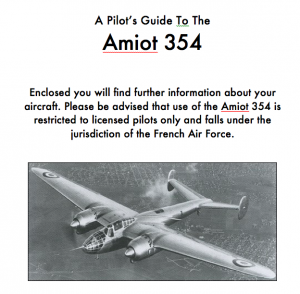After reading your comments, we have decided to design our book about a book as a presentation of an artifact from the pilot’s actual crash in the Sahara desert. We considered your input on us actually purchasing the journals, and have instead decided to use what will appear to be a pilot’s manual. We found a website titled “Militaryfactory.org” which lists the aircraft information of many planes used by various countries. Through our research of the time period the book was written in, the 1940s, we found that a plane that could have very possibly been flown by the pilot is the “Amiot 354,” a Medium Bomber Aircraft in the French Air Force. Using the website that gives specifications of such an aircraft, we are creating our own representation of the pilot’s manual. The following images are examples of three pages of what will be included in the manual. 

Similar to what you suggested that the Scarlet Letter group does, we have decided we will use a file folder (which we will get a better idea about from you in class this week) that will allow us to include a foreword. In this foreword we will cover the following components of the assignment:
- Labors that went into creating the actual work
- Analysis of how parts of the work are in conversation with the authors/artists of other works
- How works have come to be considered great and what we believe makes a work great
- Bibliography
We will print such a manual on one-sided sheets of paper, leaving the backs blank. From there, we will include the pilot’s entries on the backs of each of the pages. This will contribute to authenticity as we will explain in part of the forward because we will make it look as though the pilot realized he may not survive in the dessert and wanted to record the events of his last days. Being that he was stranded in the Sahara, it is realistic that the only thing he could use would be the manual on his aircraft, therefore he wrote his daily entries in it. The entries will describe the 8 days that he was stranded in the desert.
Similarly to how copies of “The Little Prince,” have a “Translator’s Note” in the beginning of the story, we plan to include one in addition to our foreword. In the translator’s note we will fulfill the overview of the work’s reception and preservation over time by explaining how our version of the story through the pilot’s log will again add to the already existing versions of the story.
We will incorporate the close reading analysis into parts of the pilot’s actual logs and keep the authenticity of the first person aspect of our book, by using passages of text coming solely from the prince. In this way we can truly go into all of what was being said in the text, but it can be presented from the perspective of the pilot. We will write these log entries as the pilot contemplating something said by the prince, and perhaps how it affects himself.
We will also incorporate the creative response into the actual logs themselves by including a map of what the pilot believes is the positioning of the planets that the prince visited. It will be an image of the night sky in which all of the asteroids are labeled (an estimation), and finally we will see a place where he questions the placement of the prince’s planet.
It would be infeasible for us to handwrite each of the entries for all 10 copies of the book, therefore we will type the journals entries and print them onto the paper we will be using (the back of the manual). To maintain authenticity in the fact that the pilot would be hand writing all of his entries, we will use the font titled HanziPen or a similar one, which resembles handwriting.
As previously explained, we will be making the paper itself appear worn and as though it has been through hardship in the crash. To do this we will use teabags and potentially burn the sides of the pages, giving it a slightly destroyed look. In addition, we will have visible markings on the cover of the manual where the prince would have crossed out the title and wrote the meaning of the new journal, his own last days or at least what he thought would be his last days.


